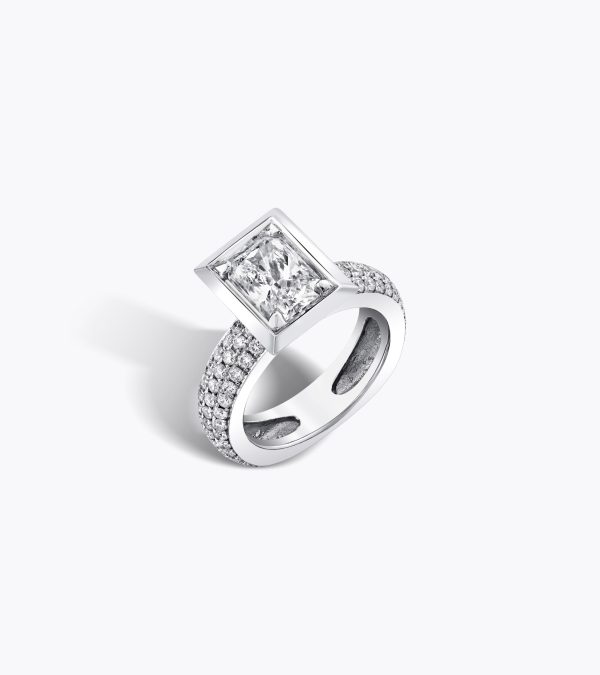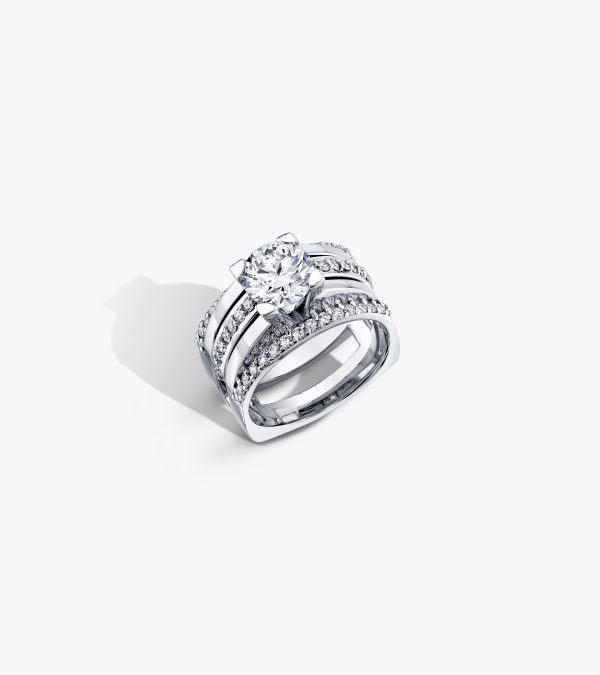480.423.5000

Lab-Grown Diamonds – Are They Real?
Are Lab-Grown Diamonds Real Diamonds?
Yes. They share the same DNA as natural diamonds. They are so much the same that most people do not notice any difference. Both share almost identical qualities, yet lab-grown diamonds are typically 45% less expensive than naturally made diamonds.
SYNCHROON Engagement Ring
A contemporary masterpiece, this ring celebrates our shared fortune of life and love. This design features a pave cathedral shank, elegantly guiding the eye toward the center. The diamond-set bezel, securing the four claw prongs, showcases the center stone’s brilliance, embodying the perfect harmony of fate and design. This ring symbolizes the beautiful synchronicity of two souls meeting and journeying together.
Lab-created or cultured diamonds look and feel like natural ones, but without the environmental impact of mining for them. Diamonds grown in a lab offer all of the beauty and brilliance that you would expect to find in a diamond. These lab-grown stones can be crafted into engagement rings or any other jewelry item for an affordable price without sacrificing quality.
Diamonds were made billions of years ago, deep under the Earth’s surface, where it’s so hot that temperatures exceed 2,000 degrees Fahrenheit and pressures hit over 7,000 pounds per square inch. The growth process took around one month in the Earth’s mantle layer. Ten to hundreds of million years ago. Volcanic eruptions then carried the diamonds to the surface. At such high temperatures and pressures, it’s a good thing nature has developed a way to transport these valuable minerals from deep within the Earth’s core. By way of volcanic pipes, which form when magma meets water at shallow depths before erupting violently.
VAST Engagement Ring
A bold statement of elegance and grandeur, this ring features a stunning rectangular center stone set within a sleek bezel. The wide band is encrusted with three rows of pave-set diamonds, creating an impressive display of brilliance. The geometric design and substantial presence of this piece make it a perfect choice for those who appreciate luxury and refined style. This ring symbolizes the vast and enduring nature of true love, capturing the essence of commitment in its magnificent form.
Lab-Grown Diamonds Are Being Grown With Two Methods.
- Chemical vapor deposition CVD
- High-pressure, high-temperature HPHT
In short, they both take a thin layer of diamond that serves as a seed and grow it into a larger diamond in two different ways.
Lab-Grown Method: CVD – Chemical Vapor Deposition
A CVD diamond gets its name from the process used to make one, chemical vapor deposition. They undergo the same process as natural diamonds. It all starts with a diamond seed. A thin layer is cut from the natural diamond to form the CVD diamond seed. This seed is the purest form of diamond, 100% carbon. The seed is then polished and prepared to the required thickness to place in the CVD plasma reactor.
Once in the reactor, it is put through a process that precisely replicates the environment in which nature makes it. The high temperatures and pressures, as found under the surface of the Earth. When the diamond is growing in a natural environment, natural impurities can occur. Nitrogen and boron can enter the diamond formation along with gases. The CVD process is controlled and doesn’t allow contaminants. So, the carbon disintegrates from the gases and forms layers over the diamond seed, crystallizing to form a pure carbon rough diamond.
The result is a type 2A diamond, the same as a natural diamond, only pure. After using precision to move the diamonds, then the cutting process begins. CVD diamonds have the same physical, chemical, and optical properties as natural diamonds. The guarantee of quality, the beauty of nature, a diamond deserves to be perfect.
HAAR
A multi-dimensional array of angles and shapes, all poised to hold something special. This ring demonstrates its value from every angle. The center stone is held in place by four prongs born from the intricate elegance below. For the powerful woman who knows her worth and the depths of her being.
Lab-Grown Method: HPHT – High-Pressure, High-Temperature
The other method used to create diamonds is using high-pressure and high-temperature, or the HPHT process. Graphite and molten metal are used as a catalyst to create the diamond.
Under these conditions, it crystallizes to form the rough diamond. Due to the influx of metal, HPHT diamonds are not the purest, as they are not 100% Carbon. Meaning they do not receive a type 2A certification from the certifying agencies.
Are Lab-Grown Diamonds the Same as Moissanite?
No. Lab-grown and natural diamonds are 99.5 to 100% carbon. Moissanite is a silicon carbide.
Are natural diamonds higher quality than lab-grown diamonds?
VLAM
A heart-stopping, big-gem ring that is a must-have for anyone who wants to flaunt a prized center stone. The beauty of this style is that it can be made to hold something smaller, but for the best effect, we recommend 3 carats and up. The center stone is set in a large straight channel and the sides have oversized pave-set diamonds. This is a ring that blazes like the sun in the sky—and like your love, spares no warmth and shine.
For both natural and lab diamonds, the color and clarity can vary according to their creation conditions. For that reason, we can find both in all qualities. While there is zero control over Mother Nature, deep below the surface, there is control in a lab. A lab can grow higher quality diamonds than the average quality of natural diamonds.
Lab-grown diamonds are becoming more popular as people realize they offer everything a mined diamond does at a fraction of the cost.
Lab-grown diamonds are real, beautiful, and an environmentally friendly alternative to mined diamonds. The only thing that makes them different is their origin story. Get a diamond ring or any other piece of jewelry with the same quality as those from mines, but without the environmental impact or high price. Lab-grown diamonds are the perfect choice for those who want to buy a diamond without the ethical or environmental implications stigma of natural diamonds. Whether you’re looking for an engagement ring, anniversary present, fashion ring, or just something new to wear every day, there’s no better way to go than lab-grown.



